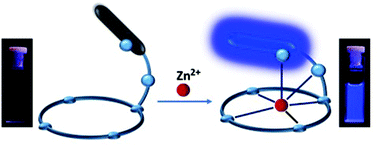Zn2+ and Cu2+ complexes of a fluorescent scorpiand-type oxadiazole azamacrocyclic ligand: crystal structures, solution studies and optical properties†
Abstract
A ligand comprised of a macrocyclic pyridinophane core having a pendant arm containing a secondary amine group linked through a methylene spacer to a pyridyl–oxadiazole–phenyl (PyPD) fluorescent system has been prepared (L). The crystal structures of [ZnL](ClO4)2 and [CuL](ClO4)2 show that M2+ is coordinated to all the nitrogen atoms of the macrocyclic core, the secondary amine of the pendant arm and the nitrogen atom of the pyridine group of the fluorescent moiety, the latter bond being clearly weaker than the one with the pyridine of the macrocycle. Solution studies showed the formation of a highly stable Cu2+ complex with 1 : 1 stoichiometry, whereas with Zn2+ least stable complexes were formed and, given the right conditions, a [Zn3L2]6+ species was also detected, but it was not possible to isolate this species in the solid state. Following Zn2+ coordination, a strong chelation-induced enhancement of fluorescence was observed, a behaviour that was not observed with any of the other metal cations tested.



 Please wait while we load your content...
Please wait while we load your content...